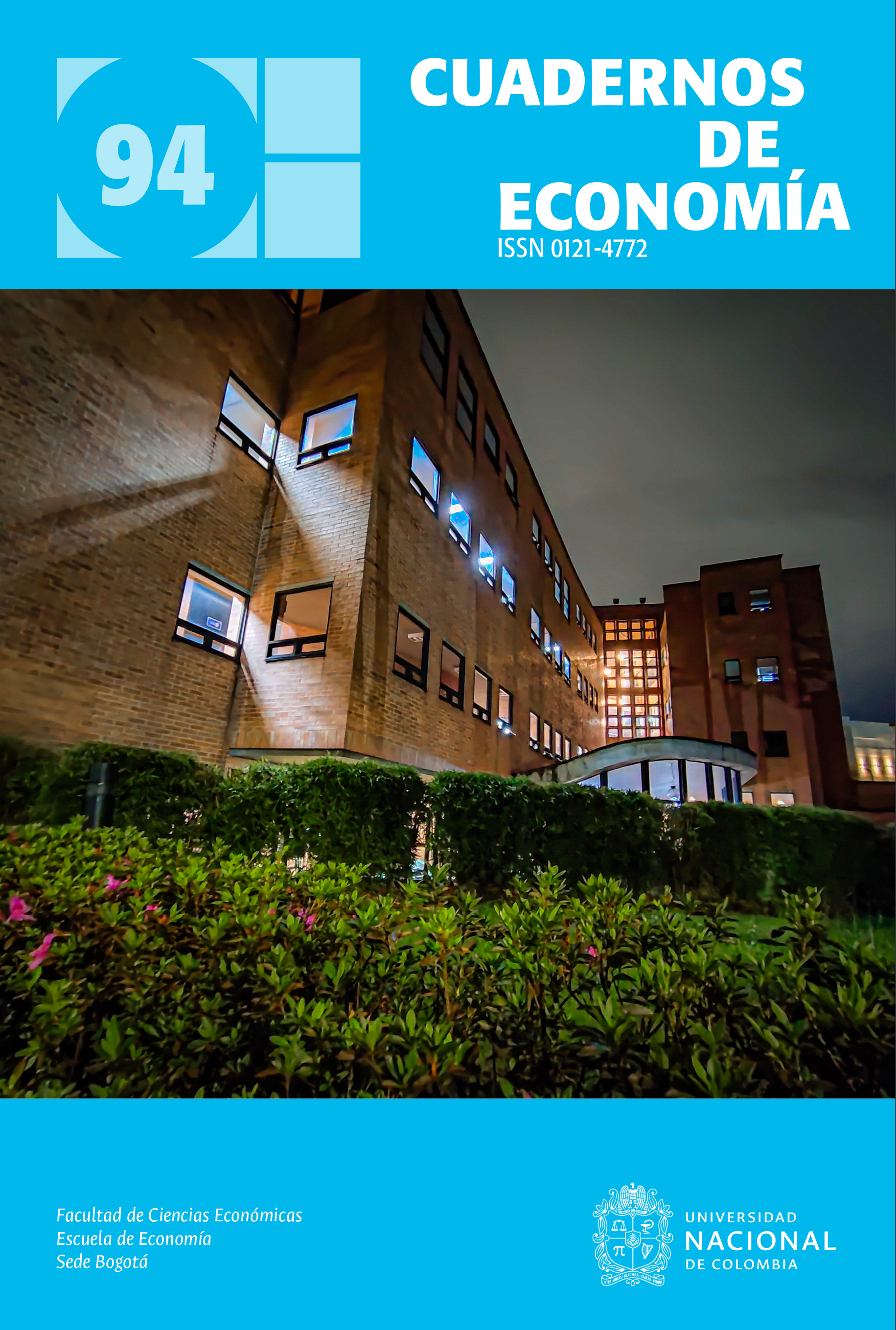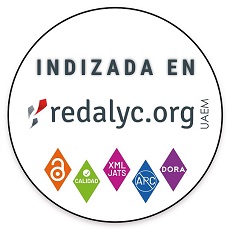Dime con quién andas y te diré quién eres: análisis de las redes de los senadores de Colombia de los períodos 2010-2014 y 2014-2018
Show me who your friends are, and I will tell you who you are: network analysis of the senators of Colombia from 2010-2014 and 2014-2018 periods
DOI:
https://doi.org/10.15446/cuad.econ.v44n94.106787Palabras clave:
teoría de grafos, Twitter, senadores, poder, leyes (es)graph theory, Twitter, senators, power, laws (en)
Descargas
Este artículo explora la relación entre el papel que desempeñan los senadores de Colombia de los periodos legislativos 2010-2014 y 2014-2018 en la estructura de red de las conexiones de los miembros del Senado en Twitter, y su poder político, representado por el número de leyes aprobadas. El modelo de Poisson con efectos fijos temporales evidencia la relación positiva entre la proporción de asientos por partido y las centralidades de vector propio y cercanía, mientras que la centralidad de intermediación, la excentricidad y si pertenece a la coalición de gobierno, tienen una relación negativa con el poder político.
In this article, we explore the relationship between the role played by Colombian senators from the 2010-2014 and 2014-2018 legislative periods in the network structure of Senate members' connections on Twitter, and their political power, as represented by the number of laws passed. We use the Fixed-effect Poisson model. We find a positive relationship between the proportion of seats per party, the eigenvector, closeness centralities and political power. In contrast, the betweenness centrality, eccentricity, and whether it belongs to the government coalition negatively affect political power.
Referencias
1. Alemán, E. (2015). Coauthorship ties in the colombian congress, 2002-2006. Colombia Internacional, 83, 23-42. https://doi.org/10.7440/colombiaint83.2015.02
2. Alemán, E., & Pachón, M. (2008). Las comisiones de conciliación en los procesos legislativos de Chile y Colombia. Política y Gobierno, XV(1),03-34.
3. Barberá, P. (2015). Birds of the same feather tweet together: bayesian ideal point estimation using twitter data. Political Analysis, 23(1), 76-91. https://doi.org/10.1093/pan/mpu011
4. Battaglini, M., & Patacchini, E. (2019). Social networks in policy making. Annual Review of Economics, 11(1), 473-494. https://doi.org/10.1146/annurev-economics-080218-030419
5. Battaglini, M., Sciabolazza, V. L., & Patacchini, E. (2018). Effectiveness of connected legislators. https://doi.org/10.3386/w24442
6. Battaglini, M., Sciabolazza, V. L., & Patacchini, E. (2020). Abstentions and social networks in congress. https://doi.org/10.3386/w27822
7. Beauchamp, M. A. (1965). An improved index of centrality. Behavioral Science, 10(2), 161-163. https://doi.org/10.1002/bs.3830100205
8. Beaujean, A. A., & Grant, M. B. (2016). Tutorial on using regression models with count outcomes using R. Practical Assessment, Research, and Evaluation, 21(2).
9. Bergé, L. (2018). Efficient estimation of maximum likelihood models with multiple fixed-effects: the R package FENmlm. Center for Research in Economic Analysis.
10. Bohórquez-Pereira, G., Flórez-Quintero, J. D., & Alguero-Montaño, M. O. (2021). Comunicación digital entre ediles y usuarios en Twitter: Oportunidad fallida en el fortalecimiento de imagen y vigencia en la esfera pública. Ánfora, 183-214. https://doi.org/10.30854/anf.v28.n50.2021.786
11. Bonacich, P. (1972). Factoring and weighting approaches to status scores and clique identification. The Journal of Mathematical Sociology, 2(1), 113-120. https://doi.org/10.1080/0022250X.1972.9989806
12. Caldeira, G. A., Clark, J. A., & Patterson, S. C. (1993). Political respect in the legislature. Legislative Studies Quarterly, 18(1), 3. https://doi.org/10.2307/440024
13. Caldeira, G. A., & Patterson, S. C. (1987). Political friendship in the legislature. The Journal of Politics, 49(4), 953-975. https://doi.org/10.2307/2130779
14. Canen, N., & Trebbi, F. (2016). Endogenous network formation in congress. SSRN Electronic Journal. https://doi.org/10.2139/ssrn.2823338
15. Chamberlain, J. M., Spezzano, F., Kettler, J. J., & Dit, B. (2021). A network analysis of twitter interactions by members of the U.S. Congress. ACM Transactions on Social Computing, 4(1), 1-22. https://doi.org/10.1145/3439827
16. Christopoulos, D. (2017). Governance networks in politics. En Networked governance (pp. 55-70). Springer International Publishing. https://doi.org/10.1007/978-3-319-50386-8_4
17. Coleman, T. F., & Moré, J. J. (1983). Estimation of sparse Jacobian matrices and graph coloring blems. Siam Journal on Numerical Analysis, 20(1), 187-209. https://doi.org/10.1137/0720013
18. Corte Suprema de Justicia. (2020, mayo 29). Corte Suprema ratifica condena contra Aida Merlano y remite sentencia al Senado para que aplique la silla vacía. https://cortesuprema.gov.co/corte/index.php/2020/05/29/corte-suprema-ratifica-condena-contra-aida-merlano-y-remite-sentenciaal-senado-para-que-aplique-la-silla-vacia/
19. Csárdi, G., & Nepusz, T. (2006). The Igraph software package for complexnetwork research. InterJournal, ComplexSsystems, 5(1695), 1-9.
20. Cunningham, S. (2022). Causal inference: The mixtape. Yale University Press.
21. Dal Maso, C., Pompa, G., Puliga, M., Riotta, G., & Chessa, A. (2014). Voting behavior, coalitions and government strength through a complex network analysis. PLoS ONE, 9(12), e116046. https://doi.org/10.1371/journal.pone.0116046
22. Del Valle, M. E., Broersma, M., & Ponsioen, A. (2021). Political interaction beyond party lines: Communication ties and party polarization in parliamentary twitter networks. Social Science Computer Review, 40(3), 736-755. https://doi.org/10.1177/0894439320987569
23. Dellavigna, S., List, J. A., Malmendier, U., & Rao, G. (2017). Voting to tell others. The Review of Economic Studies, 84(1), 143-181. https://doi.org/10.1093/restud/rdw056
24. Desmarais, B. A., Moscardelli, V. G., Schaffner, B. F., & Kowal, M. S. (2015). Measuring legislative collaboration: The Senate press events network. Social Networks, 40, 43-54. https://doi.org/10.1016/j.socnet.2014.07.006
25. Easley, D., & Kleinberg, J. (2010). Networks, crowds, and markets. Cambridge University Press. https://doi.org/10.1017/CBO9780511761942
26. Easton, D. (1965). A framework for political analysis. Prentice-Hall, Inc.
27. Freeman, L. C. (1977). A set of measures of centrality based on betweenness. Sociometry, 40(1), 35. https://doi.org/10.2307/3033543
28. Freeman, L. C. (1978). Centrality in social networks conceptual clarification. Social Networks, 1(3), 215-239. https://doi.org/10.1016/0378-8733(78)90021-7
29. Gu, Y., Chen, T., Sun, Y., & Wang, B. (2017). Ideology detection for twitter users via link analysis (pp. 262-268). https://doi.org/10.1007/978-3-319-60240-0_32
30. Hafner-Burton, E. M., & Montgomery, A. H. (2010). Centrality in politics: How networks confer power. OpenSIUC.
31. Hage, P., & Harary, F. (1995). Eccentricity and centrality in networks. Social Networks, 17(1), 57-63. https://doi.org/10.1016/0378-8733(94)00248-9
32. Halberstam, Y., & Knight, B. (2016). Homophily, group size, and the diffusion of political information in social networks: Evidence from Twitter. Journal of Public Economics, 143, 73-88. https://doi.org/10.1016/j.jpubeco.2016.08.011
33. Harary, F. (1972). Graph theory. Addison-Wesley.
34. Harris, J. (2015). Who governs? Autonomous political networks as a challenge to power in Thailand. Journal of Contemporary Asia, 45(1), 3-25. https://doi.org/10.1080/00472336.2013.879484
35. Herrnson, P. S., & Kirkland, J. H. (2016). Political parties and campaign finance networks En J. N. Victor, A. H. Montgomery & M. Lubell (Eds.), The Oxford handbook of political networks (Vol. 1). Oxford University Press. https://doi.org/10.1093/oxfordhb/9780190228217.013.16
36. Hinsliff, G. (2016, julio 31). Trash talk: How Twitter is shaping the new politics. The Guardian. https://www.theguardian.com/technology/2016/jul/31/trash-talk-how-twitter-is-shaping-the-new-politics
37. Imai, K., & Kim, I. S. (2019). When should we use unit fixed effects regression models for causal inference with longitudinal data? American Journal of Political Science, 63(2), 467-490. https://doi.org/10.1111/ajps.12417
38. Jackson, M. O., & Yariv, L. (2006). Diffusion on social networks. Économie Publique/Public Economics, 16. https://doi.org/10.4000/economiepublique.1721
39. Jacomy, M., Venturini, T., Heymann, S., & Bastian, M. (2014). ForceAtlas2, a continuous graph layout algorithm for handy network visualization designed for the Gephi software. PLoS ONE, 9(6), e98679. https://doi.org/10.1371/journal.pone.0098679
40. Kearney, M. (2019). rtweet: Collecting and analyzing Twitter data. Journal of Open Source Software, 4(42), 1829. https://doi.org/10.21105/joss.01829
41. Kim, T., Atkin, D. J., & Lin, C. A. (2016). The influence of social networking sites on political behavior: Modeling political involvement via online and offline activity. Journal of Broadcasting & Electronic Media, 60(1), 23-39. https://doi.org/10.1080/08838151.2015.1127242
42. Knoke, D., & Yang, S. (2008). Social network analysis. SAGE Publications, Inc. https://doi.org/10.4135/9781412985864
43. Lazer, D., & Wojcik, S. (2017). Political networks and computational social science. En: J. N. Victor, A. H. Montgomery & M. Lubell (Eds.), The Oxford handbook of political networks (Vol. 1). Oxford University Press. https://doi.org/10.1093/oxfordhb/9780190228217.013.9
44. Loaiza, L. (2021, marzo 15). El “Cartel de la Toga” revela alto nivel de corrupción en las cortes de Colombia. Insight Crime. https://es.insightcrime.org/noticias/cartel-toga-revela-corrupcion-colombia
45. Pachón, M., & Johnson, G. B. (2016). When’s the party (or coalition)? Agenda-setting in a highly fragmented, decentralized legislature. Journal of Politics in Latin America, 8(2), 71-100. https://doi.org/10.1177/1866802X1600800203
46. Palencia, E. A. (2012). La coalición de los partidos políticos en Colombia como elemento estratégico para mantener su legitimación. Jurídicas CUC, 8, 91-114.
47. Parmelee, J. H., & Bichard, S. L. (2013). Politics and the Twitter revolution. Lexington Books.
48. Pearl, J. (2009). Causality: Models, reasoning, and inference. Cambridge University Press.
49. Peng, T.-Q., Liu, M., Wu, Y., & Liu, S. (2016). Follower-followee network, communication networks, and vote agreement of the U.S. members of congress. Communication Research, 43(7), 996-1024. https://doi.org/10.1177/0093650214559601
50. Perez-Truglia, R., & Cruces, G. (2017). Partisan interactions: Evidence from a field experiment in the United States. Journal of Political Economy, 125(4), 1208-1243. https://doi.org/10.1086/692711
51. Rodríguez, M. Á. (2017). La parapolítica: La infiltración paramilitar en la clase política colombiana. Ánfora, 15(24), 287-305. https://doi.org/10.30854/anf.v15.n24.2008.214
52. Squintani, F. (2019). Information transmission in political networks.
53. Textor, J., van der Zander, B., Gilthorpe, M. S., Liśkiewicz, M., & Ellison, G. T. H. (2017). Robust causal inference using directed acyclic graphs: The R Package ‘Dagitty’. International Journal of Epidemiology, dyw341. https://doi.org/10.1093/ije/dyw341
54. Vaccari, C., & Valeriani, A. (2015). Follow the leader! Direct and indirect flows of political communication during the 2013 Italian general election campaign. New Media & Society, 17(7), 1025-1042. https://doi.org/10.1177/1461444813511038
55. Vaughan, D. (2013). Quantifying the value of a political connection: the case of presidential elections in colombia (Working Papers, 2013-18).
56. Victor, J. N., Montgomery, A. H., & Lubell, M. (2017). Introduction. En J. N. Victor, A. H. Montgomery & M. Lubell (Eds.). The Oxford handbook of political networks (Vol. 1). Oxford University Press. https://doi.org/10.1093/oxfordhb/9780190228217.013.1
57. Watts, D. J., & Strogatz, S. H. (1998). Collective dynamics of ‘small-world’ networks. Nature, 393(6684), 440-442. https://doi.org/10.1038/30918
58. Weber, M. (1947). The theory of social and economic organization. Free Press.
59. Wellman, B. (1983). Network analysis: Some basic principles. Sociological Theory, 1, 155. https://doi.org/10.2307/202050
Cómo citar
APA
ACM
ACS
ABNT
Chicago
Harvard
IEEE
MLA
Turabian
Vancouver
Descargar cita
Licencia
Derechos de autor 2025 Cuadernos de Economía

Esta obra está bajo una licencia internacional Creative Commons Atribución-NoComercial-SinDerivadas 4.0.
Cuadernos de Economía a través de la División de Bibliotecas de la Universidad Nacional de Colombia promueve y garantiza el acceso abierto de todos sus contenidos. Los artículos publicados por la revista se encuentran disponibles globalmente con acceso abierto y licenciados bajo los términos de Creative Commons Atribución-No_Comercial-Sin_Derivadas 4.0 Internacional (CC BY-NC-ND 4.0), lo que implica lo siguiente:





















